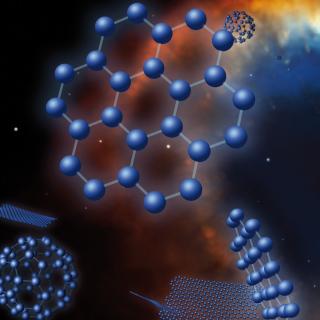Bibcode
Sit, Tawny; Weinberg, David H.; Wheeler, Adam; Hayes, Christian R.; Hasselquist, Sten; Masseron, Thomas; Sobeck, Jennifer
Referencia bibliográfica
The Astrophysical Journal
Fecha de publicación:
8
2024
Revista
Número de citas
5
Número de citas referidas
2
Descripción
Stellar abundance measurements are subject to systematic errors that induce extra scatter and artificial correlations in elemental abundance patterns. We derive empirical calibration offsets to remove systematic trends with surface gravity in 17 elemental abundances of 288,789 evolved stars from the SDSS APOGEE survey. We fit these corrected abundances as the sum of a prompt process tracing core-collapse supernovae and a delayed process tracing Type Ia supernovae, thus recasting each star's measurements into the amplitudes A cc and A Ia and the element-by-element residuals from this two-parameter fit. As a first application of this catalog, which is 8× larger than that of previous analyses that used a restricted range, we examine the median residual abundances of 14 open clusters, nine globular clusters, and four dwarf satellite galaxies. Relative to field Milky Way disk stars, the open clusters younger than 2 Gyr show ≈0.1‑0.2 dex enhancements of the neutron-capture element Ce, and the two clusters younger than 0.5 Gyr also show elevated levels of C+N, Na, S, and Cu. Globular clusters show elevated median abundances of C+N, Na, Al, and Ce, and correlated abundance residuals that follow previously known trends. The four dwarf satellites show similar residual abundance patterns despite their different star formation histories, with ≈0.2–0.3 dex depletions in C+N, Na, and Al and ≈0.1 dex depletions in Ni, V, Mn, and Co. We provide our catalog of corrected APOGEE abundances, two-process amplitudes, and residual abundances, which will be valuable for future studies of abundance patterns in different stellar populations and of additional enrichment processes that affect galactic chemical evolution.
Proyectos relacionados

Nucleosíntesis y procesos moleculares en los últimos estados de la evolución estelar
Las estrellas de masa baja e intermedia (M < 8 masas solares, Ms) representan la mayoría de estrellas en el Cosmos y terminan sus vidas en la Rama Asintótica de las Gigantes (AGB) - justo antes de formar Nebulosas Planetarias (NPs) - cuando experimentan procesos nucleosintéticos y moleculares complejos. Las estrellas AGB son importantes
Domingo Aníbal
García Hernández